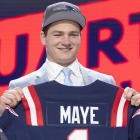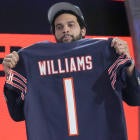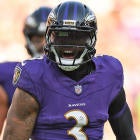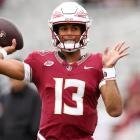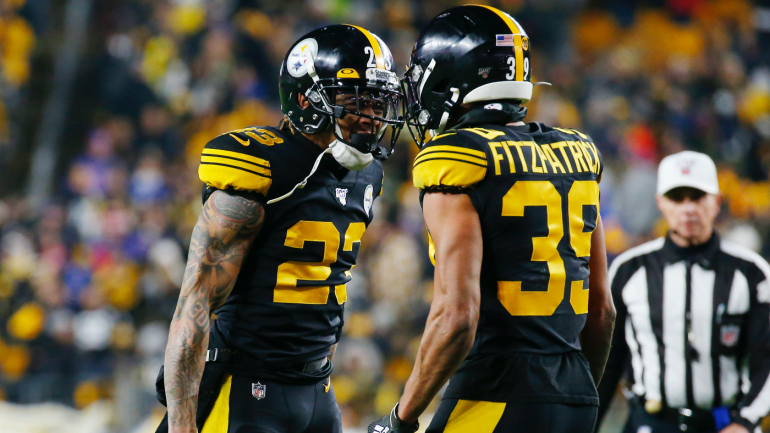
In the 87-year history of the Pittsburgh Steelers, only two teams have started a season with a 5-0 record: the 2020 Steelers and the 1978 squad that was tabbed as the third-greatest team in league history during the NFL's centennial celebration.
The '78 Steelers' roster is a who's who of NFL royalty, with 14 players/personnel members from that team currently residing in the Pro Football Hall of Fame. After winning back-to-back Super Bowls earlier in the decade, the Steelers reinvented themselves from a power running team to a passing team after the league instituted several new rules to encourage higher scoring games. The result was a 14-2 regular season along with decisive playoff wins over the Broncos (the defending AFC champions) and the Oilers, led by rookie sensation Earl Campbell. Against the defending champion Cowboys in Super Bowl XIII, four touchdown passes from Terry Bradshaw propelled Pittsburgh to a 35-31 victory, as the Steelers became the first team to win three Super Bowls.
While free agency and the salary cap have changed the way rosters are constructed, the roster that Steelers general manager Kevin Colbert and his staff have put together rivals the roster of the '78 Steelers. And while there probably won't be nearly as many players on Pittsburgh's current roster that will end up in Canton, Ohio, the Steelers, as currently constructed, are capable of joining the '78 team as world champions.
How well does Pittsburgh's current roster compare to the only other Steelers team that started a season 5-0? We compared each teams' position group to find that answer. Here are the results.
Quarterback
After relying on his raw talent during the first half of his career, Bradshaw had developed into a polished passer by his ninth NFL season. In '78, the 30-year-old Bradshaw led the NFL in touchdown passes while becoming the first (and last) Steelers player to win the league's MVP award. Bradshaw reinforced his standing as one of the NFL's elite signal callers by throwing for a then-Super Bowl record 318 yards against Dallas' famed "Doomsday" defense.
Ben Roethlisberger, a year removed from elbow surgery, is off to the best statistical start of his career. Through six games, Big Ben has thrown 11 touchdowns passes and just one interception. He is also completing a career-high 69.1% of his passes.
Advantage -- Draw: As great as Bradshaw's '78 season was, Roethlisberger is having just as good of a start to his 2020 season. If he can keep it up, Roethlisberger, who is already among the front-runners to be named NFL's Comeback Player of the Year, could become an MVP dark horse candidate by season's end.
This team was legendary.
— Pittsburgh Steelers (@steelers) November 16, 2019
Taking the #️⃣3️⃣ spot on the #NFL100 Greatest Teams list is the 1978 #Steelers. pic.twitter.com/aDMfRmmMYv
Running back
While his yards per carry (3.5 yards) was nothing to write home about, Franco Harris still managed to rush for 1,082 yards and eight touchdowns during the '78 season. Harris was complemented by dependable veteran Rocky Bleier (633 yards, five touchdowns) and Sidney Thornton.
James Conner, after an injury-marred 2019 season, is off to a strong start in 2020, as he currently leads the Steelers with 369 yards and four touchdowns while averaging 4.9 yards per carry. The Steelers have also given considerable playing time to second-year running back Benny Snell (42 carries, 165 yards) and rookie Anthony McFarland.
Advantage -- '78 Steelers: Harris and Bleier's playoff success puts them over the top ... for now. In three playoff games, Harris rushed for 224 yards and four touchdowns that included a key 22-yard touchdown run late in Super Bowl XIII. Bleier, who rushed for a touchdown in Pittsburgh's AFC title game win over Houston, came up with an impressive touchdown catch against the Cowboys just before halftime that gave the Steelers the lead for good.
WHAT. A. GAME.
— Pittsburgh Steelers (@steelers) October 5, 2019
Super Bowl XIII comes in at #️⃣1️⃣7️⃣ on the #NFL100 Greatest Games. pic.twitter.com/pwWCCkytUI
Receiver
The '78 Steelers boasted two Hall of Fame receivers in Lynn Swann and John Stallworth. An All-Pro that season, Swann caught seven passes for 124 yards that included the back-breaking touchdown in Pittsburgh's Super Bowl win over Dallas. Stallworth, who missed the second half of that game due to cramps, caught three passes for 115 yards and two touchdowns (that included a 75-yard score that tied the game) in the first half. Theo Bell and Jim Smith, the Steelers' No. 3 and No. 4 receivers, caught just 12 passes during the regular season.
Dan Rooney, the Steelers' Hall of Fame present who passed away in 2017, had said that Pittsburgh's 1995 receiving corps may have been the franchise's best group. The Steelers' current group certainly rivals the '95 bunch as far as depth is concerned. Rookie Chase Claypool has burst onto the scene with six touchdowns in his first six games. His four-touchdown effort in Pittsburgh's Week 4 win over Philadelphia is the most touchdowns by a Steelers receiver in over 50 years. JuJu Smith-Schuster has three touchdown receptions, while James Washington and Diontae Johnson have each made significant plays through six games.
Advantage -- '78 Steelers: It's hard to pick against a Hall of Fame duo, so we decided not to. That being said, Pittsburgh's current depth at receiver is a major reason for the Steelers' early success, and it will surely play a significant role if Pittsburgh manages to win it all this season.
Tight end
While Swann and Stallworth did the heavy lifting, Pittsburgh's passing attack in '78 also included significant contributions from its tight ends. Bennie Cunningham, the team's first-round pick two years earlier, was off to a torrid start before an injury ended his '78 season after just six games. Stepping up in Cunningham's absence was Randy Grossman, an undrafted member of the Steelers' fabled rookie class of 1974. Grossman, after catching 37 passes during the regular season (which was, at the time, a franchise record for single season catches by a tight end), caught nine passes during the postseason that included three big receptions against the Cowboys in the Super Bowl.
His numbers may not jump off the page, but Eric Ebron, Pittsburgh's biggest free agent acquisition during the 2020 offseason, has already found a home in the Steelers' offense. Ebron, a 2018 Pro Bowler, is currently fourth on the team in receptions and receiving yards. And while he has seen his receiving totals diminish since the arrival of Ebron, fellow tight end Vance McDonald has proven to be a valuable blocker while helping the Steelers run significantly more two tight end sets than in previous seasons.
Advantage -- '20 Steelers: As good as Grossman was, Cunningham's season-ending injury, along with the important roles Ebron and McDonald have within Pittsburgh's current offense, gives the current duo a slight edge.
Offensive line
The '78 Steelers' offensive line was anchored by Hall of Fame center Mike Webster, who that season earned All-Pro honors for the first time. Webster was flanked by longtime starters Gerry Mullins, Jon Kolb, Sam Davis and Ray Pinney, whose crushing block on Cowboys safety Charlie Waters helped pave the way for Harris on his Super Bowl touchdown run. Larry Brown, a former tight end who was part of the Steelers' 2019 Hall of Honor class, started eight games in 1978 after converting to right tackle a year earlier.
Pittsburgh's current offensive line is led by center Maurkice Pouncey, an eight-time Pro Bowler who could well be on his way to joining Webster and fellow former Pittsburgh center Dermontti Dawson in Canton, Ohio. Pittsburgh's offensive line also includes right guard David DeCastro -- a Pro Bowler each of the past five years -- and two-time Pro Bowl left tackle Alejandro Villanueva. Pittsburgh, following injuries to DeCastro, Zach Banner and veteran backup Stefen Wisniewski, have received stellar play from rookie guard Kevin Dotson and tackle Chukwuma Okorafor, a three-year veteran who has replaced an injured Banner in the starting lineup.
Advantage -- '20 Steelers: While the Steelers' '78 line was a talented group, the surprising depth of Pittsburgh's current line is one of the main reasons why Pittsburgh's offense is averaging 31.2 points per game through six games.
Defensive line
While they were not as dominant as they were earlier in the decade, Pittsburgh's formidable "Steel Curtain" defensive line was still an elite group during the team's second run of back-to-back titles. John Banaszack, an energetic, hard-charging former undrafted rookie, helped make up for the loss of Ernie Holmes, a key member of Pittsburgh's first two Super Bowl teams. Joe Greene, largely considered the greatest player in franchise history, earned his ninth Pro Bowl selection. L.C. Greenwood, a fellow member of Chuck Noll's inaugural draft class, earned his fifth Pro Bowl selection. Dwight White, a member of this year's Hall of Honor induction class, split time with Steve Furness, a savvy veteran who was a member of all four of Pittsburgh's Super Bowl-winning teams during the '70s.
The trio of Cameron Heyward, Tyson Alualu and Stephon Tuitt is a major reason why the Steelers are second in the NFL in both rushing yards and yards per carry allowed. Tuitt, who missed most of the 2019 season with an injury, already has four sacks and 12 quarterback hits this season. A Pro Bowler each of the past three seasons, Heyward recorded his first career interception during Pittsburgh's season-opening win over the Giants. Alualu, the Jaguars' first round pick way back in the 2010 draft, has become one of the best free agent signings in franchise history.
Advantage -- '78 Steelers: Pittsburgh's current defensive line should take no shame in coming up short against a '78 unit that included three members of the original Steel Curtain defensive front. The '78 front also had impressive depth that allowed Greene, Greenwood and White to stay fresh well into the postseason.
Linebackers
The '78 squad boasts two Hall of Famers in outside linebacker Jack Ham and inside linebacker Jack Lambert. Ham, who former teammate Tony Dungy once called the best outside line he has ever seen, was an incredibly cerebral player who excelled in both pass coverage and run defense. Lambert, whose prowess in pass coverage is often forgotten, was one of the most intimidating forces in NFL history. The duo was complemented by six-year veteran Loren Toews and Robin Cole, a second-year player who would end up spending 11 years in Pittsburgh, earning a Pro Bowl nod in 1984.
Pittsburgh's current linebacker group just suffered a blow when Devin Bush sustained a season-ending ACL tear against the Browns. And while Bush's loss hurts, Mike Tomlin has expressed confidence in Robert Spillane, a three-year pro who tallied six tackles in Bush's absence. The group is led by outside linebackers Bud Dupree and T.J. Watt, who have recorded a combined 9.5 sacks and 30 tackles thus far. Watt and inside linebacker Vince Williams (an eight-year veteran and four-year starter) are respectively second and first in the league in tackles for loss. As far as depth is concerned, the Steelers will lean on inside linebackers Ulysees Gilbert and Marcus Allen to also help fill the void left by Bush's absence.
Advantage -- '78 Steelers: If we're only talking outside linebackers, the '20 Steelers take the cake. But when Lambert is added into the equation, the '78 Steelers linebackers edge out the team's current group. The depth of the '78 team didn't hurt their case, either.
Cornerbacks
Despite receiving just six starts, Dungy, then in his second season with the Steelers, led the '78 team with six interceptions. Dungy, who later earned Hall of Fame induction as a Super Bowl winning-head coach, shared a defensive backfield with cornerback Mel Blount, who was so dominant the league made new rules limiting the amount of contact defenders could have on receivers prior to the start of the '78 season. Blount started alongside rookie Ron Johnson, who played well in relief of J.T. Thomas, who missed the year with an injury. Johnson shined in Super Bowl XIII, as his coverage helped Pittsburgh hold Dallas quarterback Roger Staubach to just 176 net yards passing.
Pittsburgh's weak link just several years ago, the Steelers' current group of cornerbacks is a big reason why Pittsburgh is eighth in the NFL in passing yards allowed. Steven Nelson, Joe Haden, Mike Hilton and Cameron Sutton have each recorded interceptions thus far, while Hilton's three sacks is the fourth-highest total on the team.
Advantage -- '78 Steelers: At 30, Blount was still at the peak of his powers in '78, as his interception of Staubach in Super Bowl XIII set up Pittsburgh's go-ahead touchdown. Dungy's play that season, along with Johnson's youthful spunk and spirit, tipped the scales to the '78 unit.
Safeties
This was a memorable year for Donnie Shell and Mike Wagner, Pittsburgh's starting safeties during the '78 season. Shell, who retired with the most career interceptions of any safeties in NFL history, was part of this year's Hall of Fame induction class. Wagner, a two-time Pro Bowler who led the NFL in interceptions in 1973, is part of the team's 2020 Hall of Honor class. While Wagner still in the middle of his prime in 1978, Shell, whose early exploits on special teams earned him the nickname "The Torpedo," earned the first of five straight Pro Bowl selections in '78. His knifing tackle of Campbell in Pittsburgh's regular season win over Houston (after the Oilers beat the Steelers in their first matchup) helped the Steelers get a much-needed win.
After transforming Pittsburgh's defense from a good to a great unit after being traded from Miami to Pittsburgh, Minkah Fitzpatrick was largely avoided by opposing offenses during the first month of the 2020 season. Fitzpatrick finally made his long-awaited splash play on Sunday, as his pick-six of Baker Mayfield helped open the floodgates. Fitzpatrick's partner in crime, former first round pick Terrell Edmunds, has developed into a solid starter and one of the team's most consistent performers.
Advantage -- '78 Steelers: While they improved their league standing on Sunday, Pittsburgh's defense is still just 16th in third down efficiency and 12th in red zone efficiency. Part of that has to do with how defenses are avoiding Fizpatrick, as he and the Steelers will have to continue to find ways to increase his effectiveness despite how offenses play him and Pittsburgh's defense. In any event, the nod here goes to the '78 duo of Shell and Wagner, a vastly underrated part of the Steel Curtain.
Special Teams
Larry Anderson, one of the unsung heroes of Super Bowl XIV, averaged a solid 25.1 yards per kickoff return in '78. Roy Gerela made just 12 of his 26 field goal attempts, while Craig Colquitt, the father of current Steelers punter Dustin Colquitt, averaged 40 yards per punt.
The '20 Steelers' special teams has been buoyed by the play of receiver Ray-Ray McCloud, who is averaging 12.4 yards per punt return and 27.5 yards per kickoff return. And while Colquitt is not off to a great start in Pittsburgh, Chris Boswell has made all seven of his field goal attempts and all but one of his 18 point-after attempts.
Advantage -- '20 Steelers: While many of these position battles were close, this one wasn't. Boswell is arguably the best kicker in franchise history (along with Gary Anderson), while McCloud is quickly making a name for himself on Pittsburgh's return units.
In the final tally, the '78 Steelers beat out the '20 team, a result that shouldn't come as too big of a surprise considering that the '78 team is considered to be one of the best teams in league history. That being said, the '20 team had several units (specifically the running back and linebacker positions) that could make their case as the better unit before the 2020 season is over. Ultimately, the '20 Steelers won't be defined by how it compares to the '78 team; they will be defined by whether or not they will be the team that wins the franchise's next Lombardi Trophy, a task that is within their reach.
























